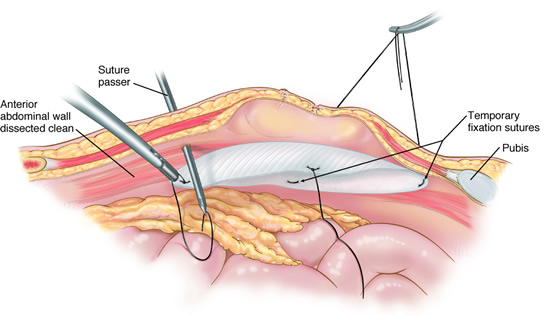Laparoscopic – Robotic Ventral And Umbilical Hernia Repair
In case of a Ventral Hernia (a bulge anywhere at the abdomen, as a result of a defect in the abdominal wall), your doctor Savvas C Hirides may suggest, surgical repair, in order to avoid common complications associated with it (strangulation- meaning a scenario in which the intestine is blocked outside the abdominal wall, under the skin and its blood supply is compromised). Most importantly, a surgical repair will be offered because there is no other way to fix a Ventral Hernia (no medication or belt can help ressolve the problem). Use of an abdominal compression waist belt, not only will not fix the issue, but it may lead to formation of dense adhesions (hard, scar-like tissue, which may lead to twisting and blockage of the intestine and also make any attempt for surgical repair more difficult). Adhesions usually appear following an open procedure; in this case a hernia will form from dehiscence of the stitches over the old wound (incisional hernia). Surgical repair of a Ventral Hernia is nowadays accomplished laparoscopically (through 3-4 small incisions on the abdominal wall of diameters 0.5-1 cm), compared to the classic (open) procedure which is still performed by a high number of surgeons who have not received appropriate training in laparoscopy, and in cases where a laparoscopic procedure is not feasible. Robotic Repair of Ventral Hernias is an evolution of laparoscopic techniques, and may offer significant advantages in selected patients. Those advantages include: a three-dimensional view, high-definition stereoscopic image of the operative field, and a higher degree of motion freedom for the robotic instruments.

During laparoscopic repair of Ventral Hernias, surgeon S.Hirides will gain access to the abdominal cavity through a 1cm incision on the lateral abdominal wall, and he will administer air (carbon dioxide) in order to expand and create the necessary workspace. Careful inspection of the peritoneal cavity takes place first. At this stage, it may be necessary to divide any adhesions of the intestinal loops with the anterior abdominal wall, a procedure that is quite difficult and time consuming.
Surgeon S.C Hirides uses specific instruments that divied the tissue via cauterization, so that the procedure is accomplished without any blood loss. Upon identification of the hernia defect, the content of its sac are carefully reduced (the surgeon brings back into the abdominal cavity, all migrated intestinal loops) and often the redundant sac is also surgically removed.
When the abdominal cavity has been fully cleaned from adhesions, a mesh must be introduced, placed and fixed below the hernia defect. The mesh is made of material that causes intense fibrous reaction, resulting in the healing and strengthening of the defect area, in the following postoperative couple of weeks.
Mesh is folded in an appropriate way in order to fit through the 1cm incision. In order to fixate it, absorbable (or rarely metallic) clips are usually used with or without biological (fibrin) glue. After making sure that placement of the mesh and bleeding control is appropriate, all instruments are removed. Also, the air is expelled from the abdominal cavity to avoid postoperative discomfort. Incisions are stitched intradermally (hidden sutures), and skin is reapproximated to its original place.
On the following day most patients will be able to mobilize and drink some liquids. Meals will start with the first signs of intestinal activity (intestinal activity may stop for a couple of hours to a couple of days following any intraabdominal procedure; this is also related to the extent of adhesiolysis needed for the procedure)
Following restoration of intestinal activity, patient can be discharged with specific instructions: to avoid exercise, and lifting of weights for the duration of one month, and to be cautious of their diet for the first couple of days following the procedure, in order to dyspepsia and bloating. Waist belts might be prescribed for a short-period of usage in very big incisional hernias.
Excellent results brought forward by our team show that patients who undergo laparoscopic/robotic procedures for ventral hernias are able to return to their workplace within 5 days after the procedure.
Translation : Katerina Vassilopoulos (London, UK)
